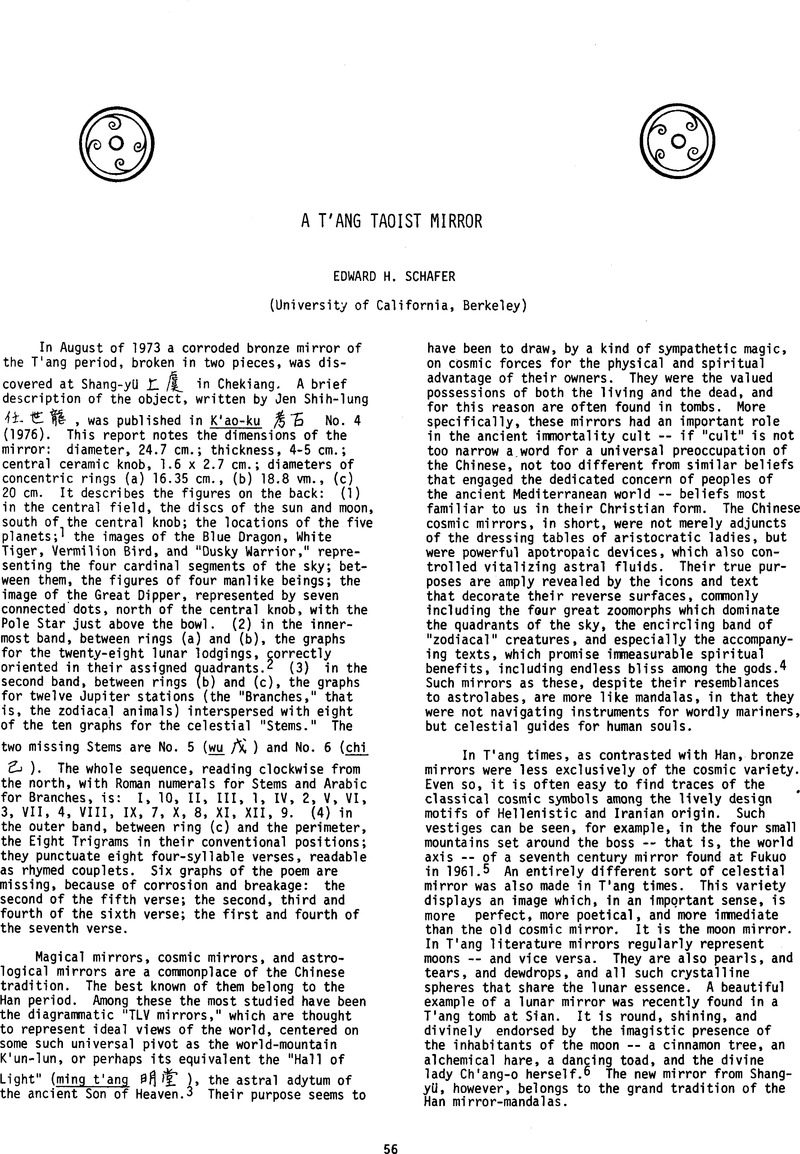Article contents
A T'ang Taoist Mirror
Published online by Cambridge University Press: 26 March 2015
Abstract

- Type
- Research Notes
- Information
- Copyright
- Copyright © Society for the Study of Early China 1978
References
FOOTNOTES
1. They are indistinct spots in the rubbing reproduced in K'ao-ku.
2. See the table of correspondences in Schafer, E.H., Pacing the Void (University of California Press, 1977), p. 76Google Scholar. Two of the graphs in the artifact's series of lodgings are unusual: ![]() for
for ![]() “Beak”;
“Beak”; ![]() for
for ![]() “Base”.
“Base”. ![]() is registered in the sixth century dictionary Yü p'ien
is registered in the sixth century dictionary Yü p'ien![]() with the meaning “name of an asterism”;
with the meaning “name of an asterism”; ![]() is a vernacular substitution.
is a vernacular substitution.
3. See, among a variety of useful sources, Cammann, Schuyler, “The ‘TLV’ Pattern on Cosmic Mirrors of the Han Dynasty,” Journal of the American Oriental Society, 68 (1948), pp. 159–167CrossRefGoogle Scholar.
4. See especially, inter alia, Thompson, Nancy, “The Evolution of the T'ang Lion and Grapevine Mirror, with an Addendum: The ‘Jen shou’ mirrors by Alexander C. Soper,” Artibus Asiae, 39 (Ascona, 1967)Google Scholar.
5. The Chinese Exhibition: A Pictorial Record of the Exhibition of Archaeological Finds ot the Peopler's Republic ot China (Nelson Gallery Foundation, 1975). Pl. 324Google Scholar.
6. Akiyama, et al., Arts of China: Neolithic Cultures to the T'ang Dynasty Kecent Discoveries (Kodansha International Ltd., Tokyo and Palo Alto, 1968) , Pl. 176Google Scholar.
7. Tao tsang, chüan 196; Harvard-Yenching Index No, 429.
8. Mercury is not named, but is the only remaining possibility.
9. It is conceivable that the female is Hsi Wang Mu ![]() , a great divinity in the Mao Shan pantheon, while the lad is “Blue Lad” (ch'ing t'ung
, a great divinity in the Mao Shan pantheon, while the lad is “Blue Lad” (ch'ing t'ung![]() ), an equally important potentate beyond the eastern sea.
), an equally important potentate beyond the eastern sea.
The role of magic mirrors in revealing the true shapes of demons, hidden beneath the transient disguises they normally assume, is described in Pao p'u tzu; however text in the Tso tsanq describe the proper techniques for using them to reveal the presence of divine beings of Highest Clarity, especially divine youths and “jade maidens.” (See Kaltenmark, Max, Mirrors magiques,” Mélanges de Sinologie offerts à Monsieur Paul Demiéville [Bibliothèque de l'Institut des Hautes Études Chinoises, Vol. XX], II [Paris, 1974], pp. 151–166.Google Scholar) The figures on the Shang-yü mirror may represent such celestial emis-saries.
10. There ere some differences between the two. The bands are broader in the mirror of HY 429 than on the artifact. The graphs in the bands in HY 429 are of the seal type; those of the artifact are of the square “official” type. The names of the lunar lodgings, as shown in HY 429, are slightly displaced towards the west in a clockwise direction; they are correctly placed on the arti fact. Except for the diagrammatic representations of the Dipper and Polaris, there are no figures in the central field as shown in HY 429; Instead, there are the names for the figures that the artisan should place there, e.g. “Greatest White Greatest Tiger” (T'ai po t'ai hu![]() ) at the correct positions for the White Tiger of the west and the Planet Venus (“Greatest White”).
) at the correct positions for the White Tiger of the west and the Planet Venus (“Greatest White”).
11. HY 431 (in Tao tsang 196). See also Pacing the Void, pp. 157-160, especially Figure 4. Szu-ma Ch'eng-chen's preface to this opuscule 1s also preserved In Ch'üan T'ang wen, 924, 16a-16b. This and the other illustrated texts are collected in chüan 196 of the Canont which comprises the subsection “Numinous Illustrations” (ling t'u![]() ) of the major division of the Ming version of the Canon called Tung hsüan pu
) of the major division of the Ming version of the Canon called Tung hsüan pu![]() , to which so many of the Highest Clarity texts have been relegated. Noteworthy among the Important sources gathered here are Shang ch'ing pa tao pi yen t'u
, to which so many of the Highest Clarity texts have been relegated. Noteworthy among the Important sources gathered here are Shang ch'ing pa tao pi yen t'u![]()
![]() (HY 430), which describes the iconography of the costumes and flying carri ages of the greatest deities of the pantheon of Highest Clarity, and Tung hsüan ling pao wu yüeh ku qen chen hsing t'u
(HY 430), which describes the iconography of the costumes and flying carri ages of the greatest deities of the pantheon of Highest Clarity, and Tung hsüan ling pao wu yüeh ku qen chen hsing t'u![]() (HY 441 ), wn1ch reveals tne secret configurations of the sacred mountains -- a text which has attracted much scholarly attention.
(HY 441 ), wn1ch reveals tne secret configurations of the sacred mountains -- a text which has attracted much scholarly attention.
12. The evidence for the mass production of cosmic mirrors is conclusive. Note, for example the near identity of the example from Ch'ang-sha (Akiyama, op. cit., Pl. 171) with the one preserved in the Nelson Gallery, Atkins Museum, shown as Figure 3 in Thompson and Soper, op. cit.; quite aside from iconographie correspondences, they are both provided with the same text, in four-word verses, displaying typical Taoist-astral beliefs.
- 1
- Cited by


